
Sign Posts and Supports

Highway and traffic signs use a number of different types of supports.
All sign supports on highways within the clear zone must either be of a breakaway type meeting crashworthiness criteria of either NCHRP Report 350 (for sign supports installed prior to December 31, 2019) or the AASHTO Manual for Assessing Safety Hardware (MASH), or be protected by guardrail, barrier, or an energy absorbing system meeting NCHRP Report 350 or MASH criteria.
Wood and steel are the two primary materials used for small sign supports. Larger sign supports, such as cantilever structures or sign bridges, are usually made of steel. Other metals such as aluminum may be used.
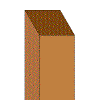
|
Wood posts are used in a number of states for permanaent or temporary signs. These posts usually come in sizes from 4x4 inches to 6x8 inches, with larger box beam sizes made of laminated plywood used for larger guide signs. All posts above 4x6 inch nominal size must be drilled perpendicular to traffic flow to allow the post to break away when struck by a motor vehicle, yet still maintain rigidity against wind forces and other non-impact loads. Permanent wood sign posts are made of redwood or pressure-treated softwoods. Temporary sign posts can be made of non-treated wood. |
There are four primary types of steel shapes used for sign supports:
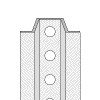
|
U-Channel: This post type is often preferred for maintenance and light construction applications, since it is easy to directly drive into the ground and assemble, and has low cost. Sizes are defined by weight per foot; i.e. "3 lb/ft post". Disadvantages of U-channel include its lower loading capacity and the inability to mount signs at right angles on the same post. No more than 3 U-channel posts should be used for a single sign without addition of a breakaway feature. |
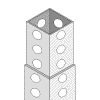
|
Square Tube: This post type is characterized by a square shape, sometimes perforated by mounting holes at 1 inch spacings. Sizes are defined by outside square dimensions. Standard sizes range from 1 1/2 inches to 2 1/2 inches in 1/4 inch increments. A square tube post can be made much stronger or spliced by inserting another smaller square tube post inside. This is called creating a "telescoping" post. The advantages of square tube posts are excellent flexibility in mounting options, greater loading capacity over U-channel, the ability to mount signs on 4 sides of the post, and the ability to quickly replace damaged posts by pulling the old post out of the foundation and inserting a new post. Disadvantages include a moderately higher cost per installation over U-channel. Some sizes and combinations of square tube posts may require the use of slip bases or other breakaway features to meet crashworthiness criteria. |
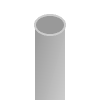
|
Tubular Steel: This post type is characterized by a round steel tube or pipe shape. Sizes are defined by nominal steel tube diameters. The sign panels are either bolted directly through the post or clamped to the outside of the post. The advantages of tubular steel posts are low cost, the ability to use commonly available steel pipe, and the ability to mount signs at any desired angle. Disadvantages include the need to field-drill the post or use special clamps to attach signs, and the requirement to use special proprietary breakaway hardware for larger post sizes if installed in the clear zone. There are variants on tubular posts offered by vendors that use a different shape and cross-section for the post, but share many of the same characteristics as standard tubular posts. |
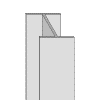
|
Breakaway: This post type is characterized by an I-beam type shape. Sizes are defined by standard AISC beam designations. The upper portions of steel breakaway posts are often "coped" or diagonally cut away to reduce the total weight of the post system. The advantages of large steel I-beam posts are the ability to support very large sign panels, and the ability to quickly replace damaged posts by bolting a new post onto the existing breakaway foundation. Disadvantages include a difficulty in breaking away safely except in a single direction, unless special proprietary hardware is used. |
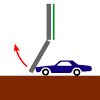
|
All large steel posts use a breakaway feature, unless protected by barrier or placed out of the clear zone. This is usually accomplished by adding a slotted plate to the top of the foundation post and another slotted plate to the bottom of the sign post, and by cutting the post just below the sign panel and adding a hinge system. The bottom plates are then bolted together at a specified torque. When struck, the post slips off the foundation at the bottom, and rotates around the hinge plate below the sign panel (see diagram). This allows the vehicle to safely pass under the sign after impact. |
Whenever reasonably feasible, existing structures such as overpasses should be used for support of overhead signs. This reduces cost and improves safety by minimizing the number of separate structures needed.
There are two major types of overhead signs:
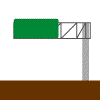
|
Cantilever: Cantilever signs are used to place a single sign or multiple smaller signs over one side of a highway. Different styles of cantilever signs include tapered steel tube, single steel tubular, and truss type construction. |
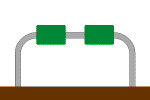
|
Sign Bridge: Sign bridges are used to place single or multiple signs over specific lanes or portions of a highway. Different styles of sign bridges include tapered steel tube, single steel tubular, and truss type construction. |
Updated 30 October 2019 (updated to new style and revised)
Scripting: Richard C. Moeur
All text and images on this page © Richard C. Moeur. All rights reserved.
Linked sign layout files in PDF format provided courtesy of
FHWA's MUTCD website
Unauthorized use of text, images, and other content is strictly prohibited. Refer to
Copyright, Disclaimer, and Standard Use Agreement
for details.